

The Chinese style is a formation of three stones on one side that has established itself over the past 25 years of professional Go as a major opening.

The characteristic play in the Chinese is 5 here, on the side. The combination of 3 and 5, the so-called 'Chinese enclosure', has by now been studied in depth. Compared to a normal enclosure of the right-hand corner, it relates in a more obvious way with the 4-4 point in the left-hand corner. This order 1-3-5 is usual - the Chinese style developed concurrently with the fashion to start the game on a 4-4 point - but 3-1-5 is seen too.
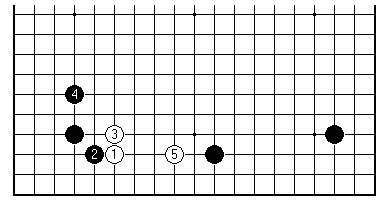
Playing the Chinese enclosure means that Black can restrict White to an inefficient extension 5, if White enters the framework at 1 here.
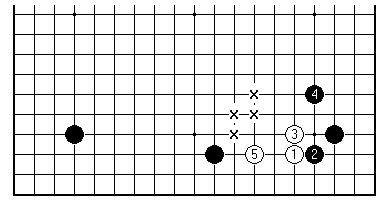
If White plays a low approach to the other corner, the available extension on the third line, to 5, provides too small a base. Therefore White in practice would look to play at one of the 'x' points. It is, however, poor strategy for White to create a weak group like this. Black can expect to build up the framework to the left by attacking it.
If you play the Chinese, your opponent will take two other corners. That means that you are nailing your flag to the mast, devoting yourself to cultivating a single framework, much more so than with (say) the mini-Chinese. In the early days White too experimented with the Chinese formation, but now it is generally seen as a strategy for Black. The history is quite tangled.
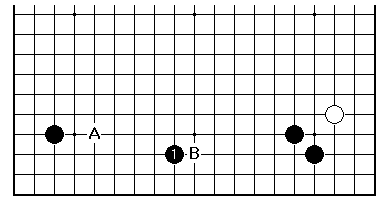
A century ago this use of the Chinese enclosure was common enough. If Black made the enclosure at A first, White would have a perfect wedge at B.
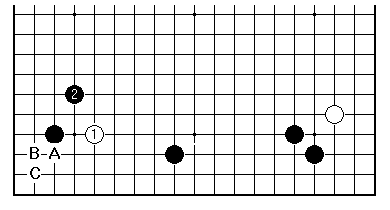
White normally came in at 1 here. After Black 2 White tended to leave the stone played to its own devices, relying on Black not being able to capture it on a large scale. The sequence White A, Black B, White C remains as aji in the corner, so there is some justification.
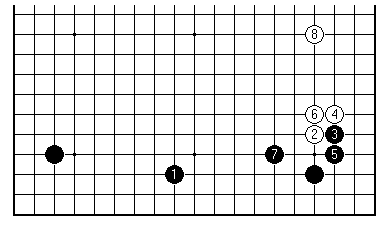
Kitani Minoru tried the Chinese enclosure in a top match in 1959 (Honinbo Final game 3, against Takagawa). Black 7 makes a balanced formation along the side. This was after earlier experiments by Go Seigen and Kitani with plays at 1, in positions where the right-hand corner was already conventionally enclosed.
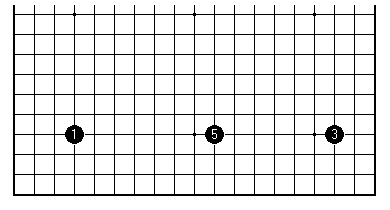
In the 1961 Amateur Honinbo tournament, Harada, one of the Big Four recognised top amateurs in Japan, played this 1-3-5 formation. Now called the 'high' or 'revised' Chinese, it enjoyed a tremendous vogue from its introduction in pro play in 1974. These days the original 'low' Chinese is more popular once more, perhaps because it appeals to territorial players while the influence-seekers adopt purely 4-4 point openings.
The scene then does really move to China. Chen Zude, now the doyen of Chinese professional Go, was looking for a flexible and convincing strategy for a match against the formidable Kajiwara Takeo 9 dan. This search is described in the Yutopian book Beauty and the Beast, as Chen prepared for the deadly serious business of a China-Japan "friendship" encounter. After games in 1965 the pattern went underground for a while, surfacing in the 1968 Nihon Ki-in Championship played by Shimamura, and noted at the time as a "souvenir from China" after another friendship tour. Kajiwara often played the Chinese enclosure in other contexts. It took another five years after that for it really to hit the headlines, becoming high fashion in 1973. The major source in English, The Chinese Opening by Kato, is a translation of a Japanese book from 1977, and therefore covers only a fraction of the professional research on this opening.

To explain in broad terms White's ways of dealing with the Chinese: there is a progression from left to right, and showing increasing complexity, as indicated by the labels in this diagram.
We'll look in greater detail at all of this as the series continues. Judging by games on the Go Teaching Ladder, the Chinese styles (low and high) are enormously popular still amongst amateurs.
For the moment, something that sticks out like a sore thumb from the previous diagram. Not to be needlessly mysterious, here's an explanation.
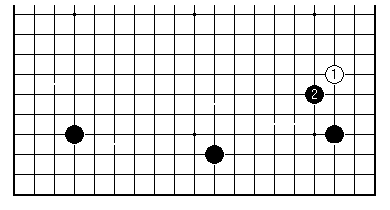
What about White 1 here? It seems not to be chosen by pros, and one can look for a reason. Eventually they get round to trials of all the reputable possibilities in a position. Black 2 is a very good play in this case, certainly. White by pushing moves against it will only help to build up Black's right corner.
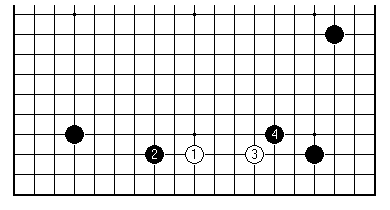
Exactly that relationship with the Chinese enclosure has been seen in very many recent games featuring the mini-Chinese. As we show it, the mini-Chinese Black has created stretches up the right-hand side of the board. That then forms, with the Black 4-4 point in the left corner, an example of what my colleague John Fairbairn insists on calling the 'Sideways Chinese'. Be that as it may, this is currently most modish. White plays the wedge at 1, reasonably enough (the alternate wedge one to the right may be no better). Then Black 4 is ideally placed. There is no real problem for White to settle the group, but if Black thereby consolidates the right corner it may prove expensive.
[01]
[02]
[03]
[04]
[05]
[06]
[07]
[08]
[09]
[10]
[11]
[12]
[13]
[14]
[15]
[16]
[17]
[18]
[19]
[20]
[21]
[22]
[23]
[24]
[25]
[26]
First published 23 November 2000 as On Your Side on MindZine,
Go Learning
© Charles Matthews 2000.